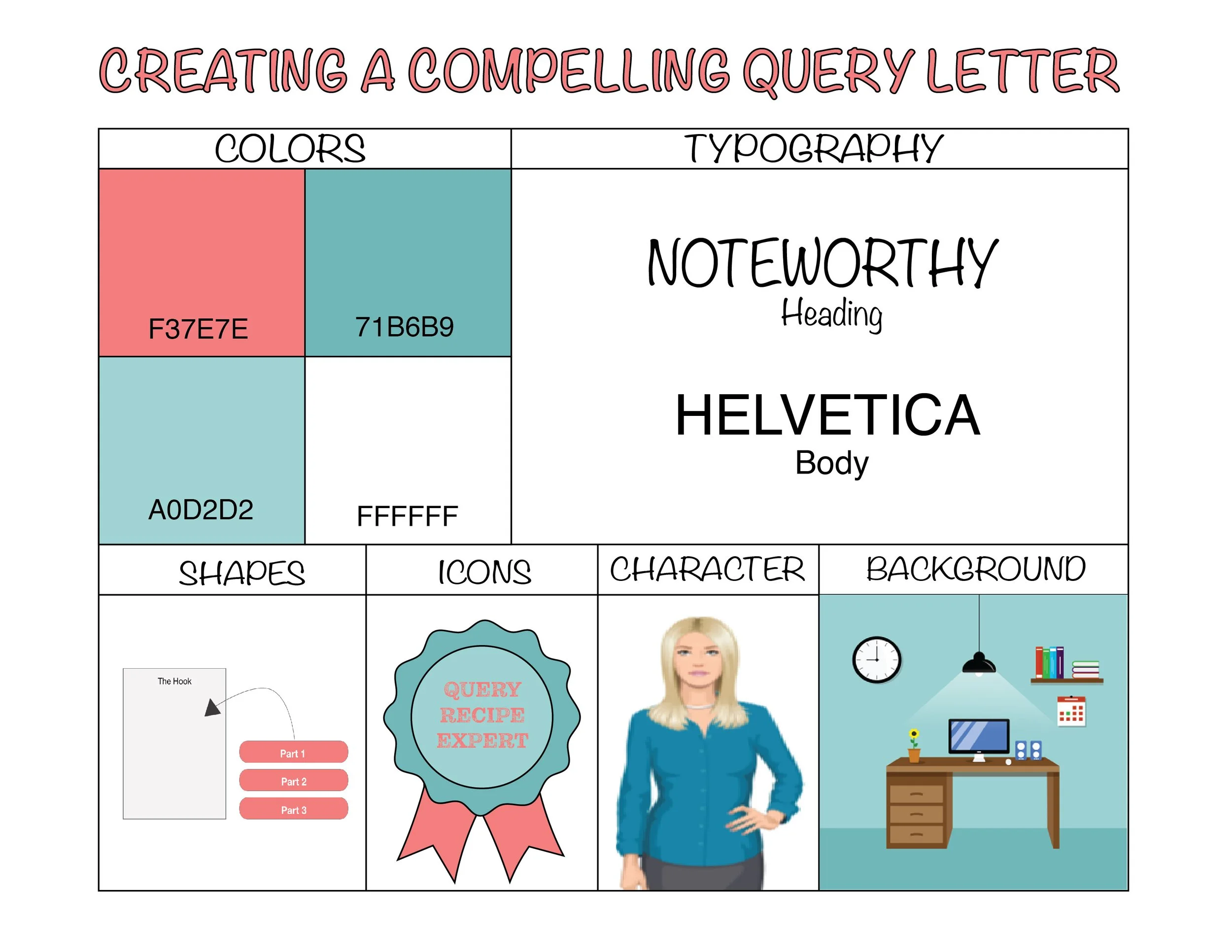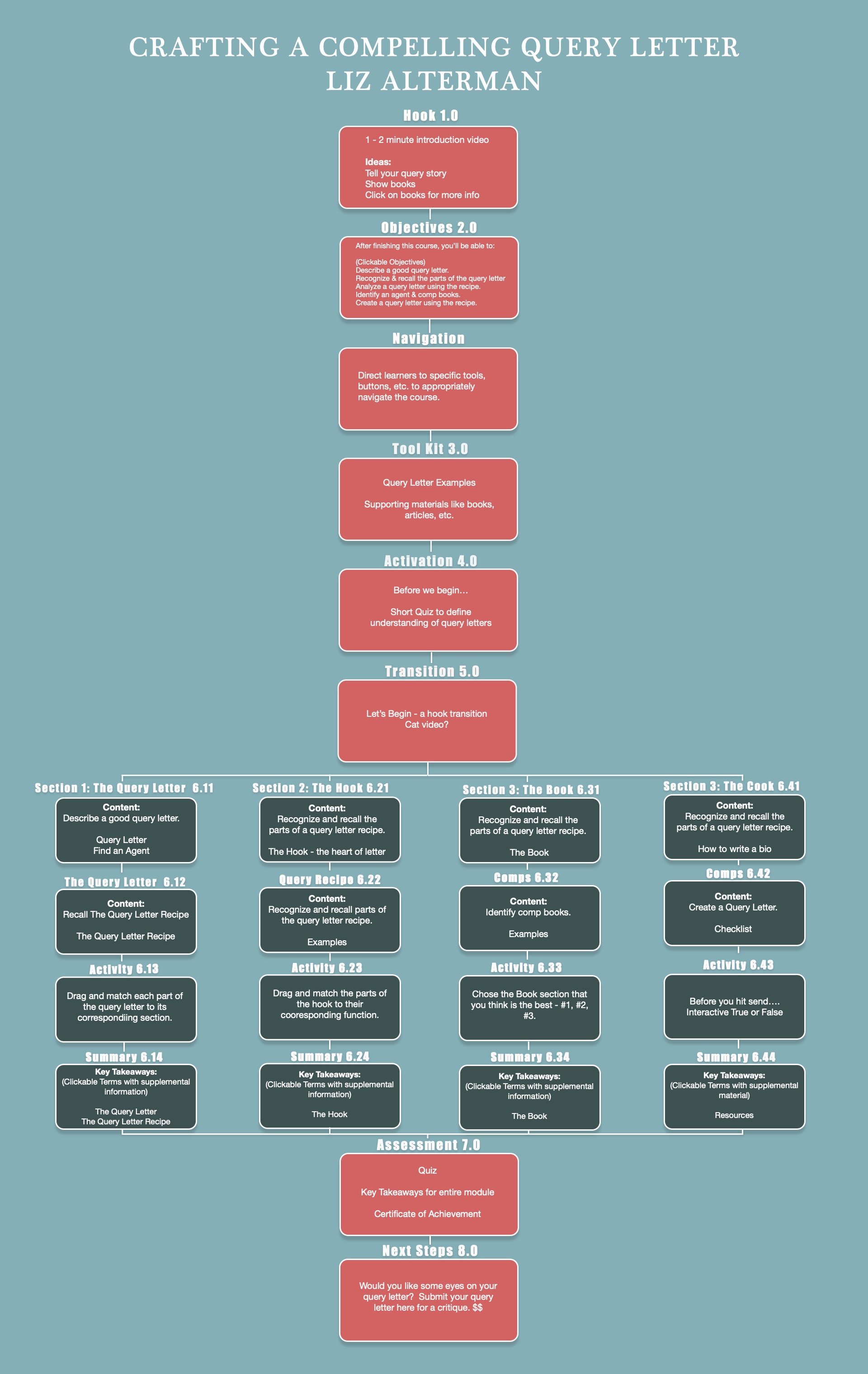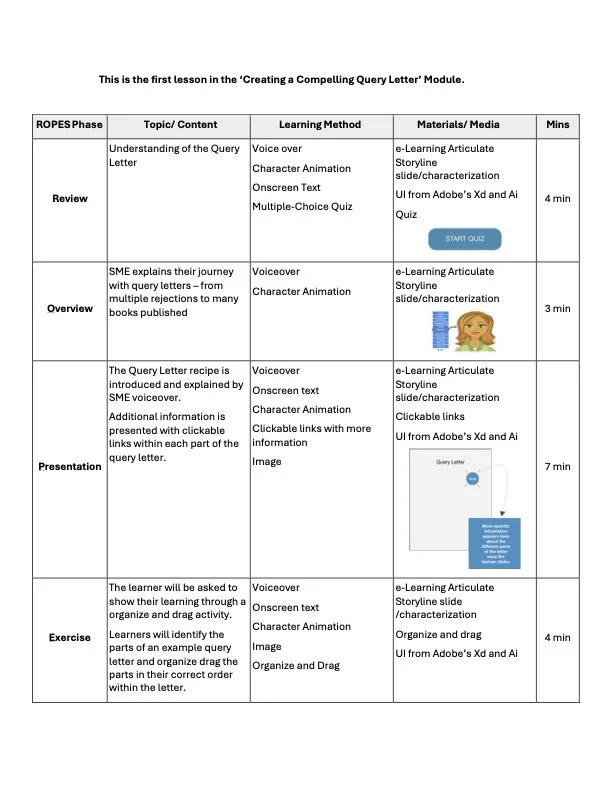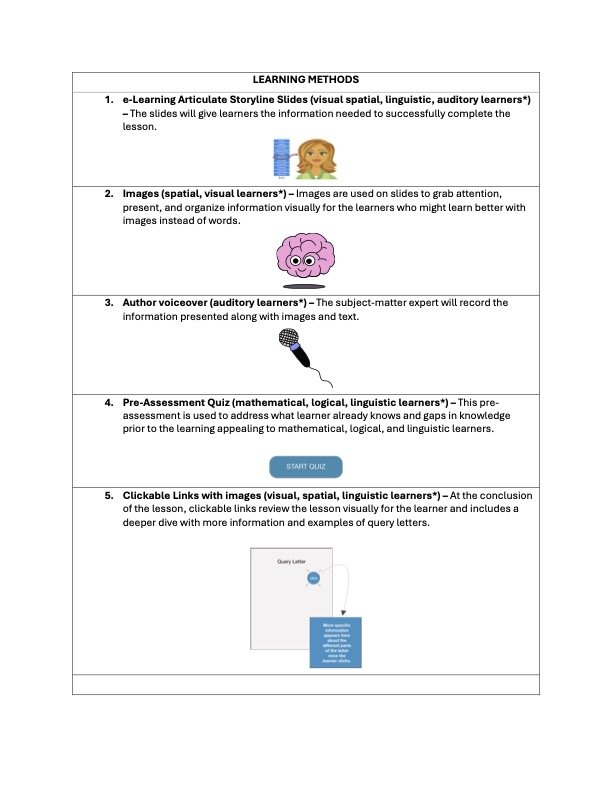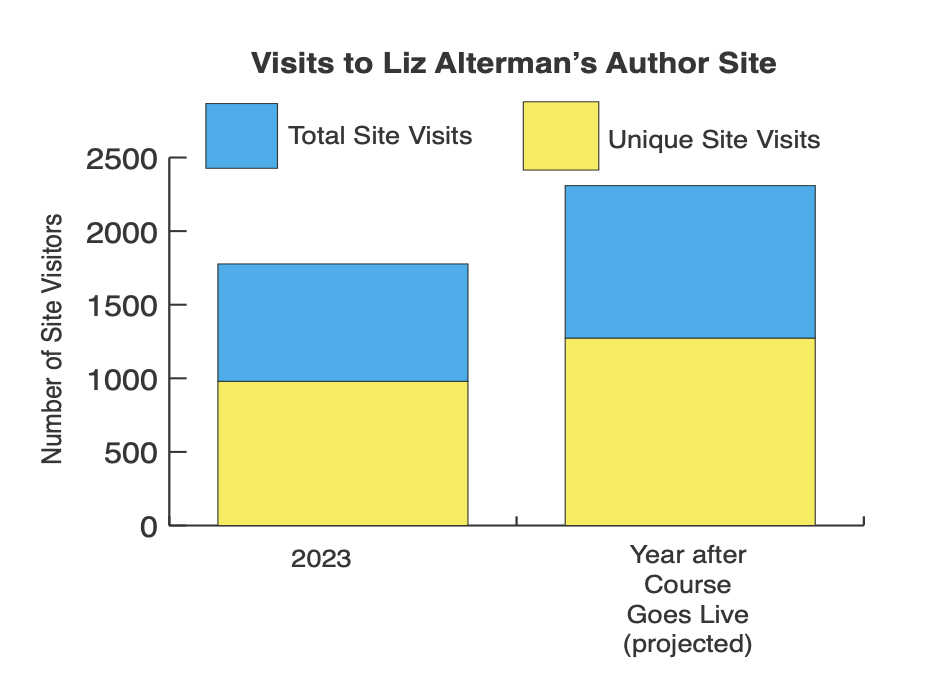Crafting a Compelling Query Letter Course: From Creation to Completion Using ADDIE
THE AUDIENCE
Aspiring authors
Liz’s readers
New & Experienced Creative Writers
Creators
DUTIES
Learning Experience
Instructional Design
Illustrations
Graphic Design
Prototype
TOOLS USED
Articulate Storyline
Adobe Xd
Adobe Illustrator
Google Suite
Microsoft Word and Powerpoint
Introductory Video for Marketing the Course
Introduction to the Course - Graphics Designed by Keri
ADDIE IN ACTION
ANALYSIS
Liz Alterman is the author of the young adult novel He’ll Be Waiting, the adult novel The Perfect Neighborhood, and the memoir Sad Sacked. Her work has appeared in The New York Times, The Washington Post, McSweeney’s, and other outlets. Liz recently hired me to develop a How to Write a Query course to drive traffic to her website and earn passive income.
The two organization outcomes are:
1. The How to Write a Query Letter course will help increase traffic to the author’s website by 30%.
2. The increased traffic from the course will lead to increased sales of the author’s books by 20%.
Query letters are essential to introducing creative work to a literary agent or author. Liz has sold four books to publishers and worked with five literary agents, so she’s successfully written query letters and is considered a subject matter expert. Since many aspiring authors visit her site and attend her face-to-face seminars and workshops, this course will tie in nicely with her brand.
Liz sees this project (Crafting a Compelling Query Letter) as a passive income opportunity with the ability to earn extra income if customers buy a query critique after participating in the course. She aims to help participants write a successful query letter and eventually sell their book or acquire an agent. The business goal is to drive customers to her site, buy her books, and build her audience.
The Data
From January 1st to January 31st, the site had 98 trips with 82 unique visits. From February 1st to February 29th, Liz’s author website had 118 visits, with 102 unique visits.
During 2023, the site had 979 visits throughout the year and 798 unique visits.
Sales of Liz’s current books are not available currently as the publisher is behind on sending the data.
A brief time-sensitive research of query letter courses created by authors yielded 67,000 video results for How to Write a Query Letter. These tutorials included videos of other authors, instructors, and everyday people explaining how to write this type of letter. On Udemy, an online learning and teaching marketplace, 1,194 courses were dedicated to either the craft of creative writing with queries mentioned or the craft of writing a query letter. Like the videos, these courses included an instructor talking on video but no ‘game-like’ interaction with the material. The new Writer’s Digest University, an online course website launched from the magazine Writer’s Digest, offers a query letter course that allows participants to work with expert instructors one-on-one. The video and critique courses range in price from free videos to $149.99. Many authors offer courses but choose to host these courses on online instruction marketplaces like Udemy and Skillshare. The research showed that most How to Write a Query Letter courses are video-based with a passive learner.
DESIGN
The first step when designing a course is to develop the brand. I studied Liz’s website and book covers to develop course colors that were utilized throughout the planning of the course. Furthermore, the course will use Articulate Storyline to produce interactive, ‘game-like’ instruction (gamification) to distinguish Liz from the rest of the How to Write Query Letter instructional design pack. This course will be offered as instruction and a critique for a discounted price or instruction and critique separately for the total cost.
Using Bloom’s Taxonomy, Gardner’s Multiple Intelligences, and the ADDIE model as main theories guiding the design, Liz and I met to review the original and newly developed wireframe. Minor adjustments were made, including adding Comp Titles and an agent search. We also discussed the next step - a Project Scoping Plan. After our meeting, a Scoping Plan was developed to give a brief organizational overview of the course and a screenplay to show the course's details.
Brand Course Design
Using Bloom’s Taxonomy, Gardner’s Multiple Intelligences, and the ADDIE model as main theories guiding the design, Liz and I met to review the original and newly developed wireframe. Minor adjustments were made, including adding Comp Titles and an agent search. We also discussed the next step - a Project Scoping Plan. After our meeting, a Scoping Plan was developed to give a brief organizational overview of the course and a screenplay to show the course's details.
Wireframe
Scoping Plan
A Sampling of the Screenplay
Learning Objectives and Sample Lesson Ideas
I developed the course objectives using twenty-five years of experience writing course objectives. I've included a sample of Lesson One below.
Module 1, Lesson 1 Content: The Query Letter
Overall E-Learning Course Objective: Given the three elements of the query letter recipe (hook, book, cook), learners will create a query letter including all three elements.
Lesson Objective: Given the three elements of the query letter recipe (hook, book, and cook), students will identify the three elements within an example query letter.
This is the first lesson in the ‘Creating a Compelling Query Letter’ Module.
DEVELOPMENT
Below is a sampling of some of the Learning Methods proposals used in the course.
Graphics Designed by Keri
Learning Methods Further Explored: The Organize Drag and Drop Activity (Slides 5.3)
The Organize and Drag or Drag and Drop Activity is a fun interactive element that makes learning fun and engages learners. This approach adds a unique kinesthetic activity to e-learning, allowing for active participation, a deeper understanding, and effective instruction. For this drag-and-drop sequencing activity, learners demonstrate the effective organization of the hook, the book, and the cook of an example query letter. This method of instruction shows that the learner thoroughly understands where the parts of a query letter should be.
According to Gagne’s Nine Events of Instruction, the Organize and Drag or Drag and Drop activity assesses performance and provides feedback to the learner to show if learning has been obtained. This activity aligns with the lesson’s learning objective and is the first step toward the ultimate learning goal of learners writing their query letters. The interactive element appeals to the ‘learn by doing’ retention model and Gardner’s kinesthetic learners.
Gamification will be utilized in this e-learning course to differentiate it from other query letter courses (see Deliverable 1). Drag-and-drop is considered part of gamification due to its high level of engagement and the overall enjoyment that learners feel after successfully sequencing the parts of the query letter. Upon completing this activity, a congratulations message and a completion badge are awarded (more gamification).
Graphics Designed by Keri
Learning Methods Further Explored: The Pre-Course Knowledge Check Interactive Quiz (Slides 4.1 - 4.13 )
IMPLEMENTATION
Prototype of the Organize Drag and Drop Activity (Slides 5.3)
Slide 5.2 - Introduction
Slide 5.3 - Drag and Drop
Slide 5.3 - Drag and Drop
Slide 5.3 - Drag and Drop
Slide 5.3 - Drag and Drop
Slide 5.3 - Incorrect Submission
Slide 5.3 - Drag and Drop
Slide 5.3 - Correct Submission
Prototype of the Pre-Course Knowledge Check Interactive Quiz (Slides 4.1 - 4.13 )
Slide 4.1 - Audio Start Quiz
Slide 4.2 - Question 1
Slide 4.3 - Q1 - clicked ‘yes’
Slide 4.4 - Q1 - clicked ‘no’
Slide 4.5 - Question 2
Slide 4.6 - Q2 - clicked ‘yes’
Slide 4.7 - Q2 - clicked ‘no’
Slide 4.8 - Question 3
Slide 4.9 - Q3 - clicked ‘yes’
Slide 4.10 - Q3 - clicked ‘yes’
Slide 4.11- Question 4
Slide 4.12- Q4 - clicked ‘yes’
Slide 4.12- Q4 - clicked ‘no’
Videos and Prototypes of Query Letter Recipe Lesson with Corresponding Activity (Slides 5.1 and 5.2)
Slide 5.1 - Intro to Query Letter
Slide 5.2 - Query Letter
Explanation: This Query Letter Recipe Lesson was included to show the knowledge gained before the Drag and Drop Organizational Activity (Slide 5.3) included in this deliverable. This interactive example includes audio, text, kinesthetic, linguistic, and visual learning to engage all e-learners.
Slide 5.2 - Button Reveal
Slide 5.2 - Button Hover
Slide 5.2 - Click Activity
Slide 5.2 - The Hook Hover
Slide 5.2 - The Hook ‘click’
Slide 5.2 - The Book hover
Slide 5.2 - The Book ‘click’
Slide 5.2 - The Cook hover
Slide 5.2 - The Cook ‘click’
EVALUATION
Level 1: Prototype of Learner Satisfaction Survey (Slides 10.1 - 10.6)
Note: The open-ended survey allows for honest feedback and varied responses to generate uninhabited answers from learners after they’ve completed the course. This open-ended survey allows for gathering marketing testimonials in the initial stage (first 25- 50 learners). *After sufficient testimonials are collected, a multiple-choice learner satisfaction survey will be initiated for specific data gathering. *
Slide 10.1 - Intro to Survey
Slide 10.1 - Button
Slide 10.2 - Survey Question 1
Slide 10.3 - Survey Question 2
Slide 10.4 - Survey Question 3
Slide 10.5 - Survey Question 4
Slide 10.6 - Survey Question 5
Slide 10.6 - Transition
Level 2: Prototype of Final Learning Multiple Choice Assessment (Slides 9.1 - 9.7)
Note: Learners will be given unlimited tries and time to choose the correct answer since this is an asynchronous e-learning course. However, the report sent to ID will show the learner’s first answer, giving true results. They will not advance to the next question until they have chosen the correct answer. This format allows for self-paced learning and quick feedback, which aligns with the goals of the e-learning course.
Slide 9.1 - Assessment Intro
Slide 9.1 - Assessment Invite
Slide 9.2 - Question 1/5
Slide 9.3 - Question 2/5
Slide 9.4 - Question 3/5
Slide 9.5 - Question 4/5
Slide 9.5 - Question 5/5
Slide 9.6 - Incorrect (each question)
Slide 9.6 - Correct (each question)
Slide 9.7 - Quiz Results
Slide 9.7 - Quiz Results Final
Level 3: Creation of Query Letter
Overall E-Learning Course Objective: Given the three elements of the query letter recipe (hook, book, cook), learners will create a query letter including all three elements.
Creation of Query Letter (Level 7 - Bloom’s Taxonomy): Initially, Liz will offer a free query letter critique to the first ten learners who complete the e-learning course. After that, the critique will be offered for a discount along with the course. During this critique, Liz can observe if the learning objectives were met using a rubric that measures the objectives. More specifically, Liz will evaluate whether the learner included the hook, book, and cook along with their specific elements in the correct order within the query letter. Liz will also assess whether the learner included appropriate comp titles and targeted an agent or editor best suited for their book. The rubric also allows for open-ended comments and space for comments within the rubric sections to address specific issues.
Level 4: Evidence of Organizational Outcome
1. The How to Write a Query Letter course will help increase traffic to the author’s website by 30%.
Evidence for Organizational Outcome #1: One month and one year after launching the course, Liz will collect the number of visits (total and unique) from her website and compare the numbers to pre-launch to see if the goal of 30% was met. Below are the total and unique projected site visits.
Liz Altermann, Author of Sad Sacked, The Perfect Neighborhood, The House on Cold Creek Lane, and He’ll Be Waiting







